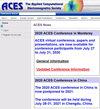Temperature Controlled Terahertz Absorbers based on Omega Resonators
IF 0.6
4区 计算机科学
Q4 ENGINEERING, ELECTRICAL & ELECTRONIC
Applied Computational Electromagnetics Society Journal
Pub Date : 2023-09-18
DOI:10.13052/2023.aces.j.380508
引用次数: 0
Abstract
In this article, the structural stability of a metasurface absorber that works at 2.8 THz is analyzed. Since the absorber is made of metallic titanium, its elemental inclusions will be heated up and expand when absorbing electromagnetic waves. To evaluate the accumulated heat, the structural thermal expansion and the stability of the wave-absorbing performance, electromagnetism-thermodynamics-structural mechanics multiphysics simulations are conducted. Based on the thermal stability study, thermistors are further introduced into the metasurface, leading to two thermal controlled terahertz absorbers. Numerical experiments show that the absorbers present a peak absorption coefficient of 92.7% at 2.79 THz up to the temperature of 1761.4 K. When the temperature rises, the absorption frequencies of the two absorbers shift to 3.51 THz and 3.94 THz, with the peak absorption coefficients of 92.8% and 93.8%, respectively.基于欧米茄谐振器的温度控制太赫兹吸收器
本文分析了工作在2.8太赫兹下的超表面吸波器的结构稳定性。由于吸收体是由金属钛制成的,它的元素内含物在吸收电磁波时会被加热膨胀。为了评估聚积热量、结构热膨胀和吸波性能的稳定性,进行了电磁-热力学-结构力学多物理场模拟。在热稳定性研究的基础上,进一步将热敏电阻引入超表面,形成两个热控太赫兹吸收体。数值实验表明,在温度为1761.4 K时,在2.79 THz处的峰值吸收系数为92.7%。当温度升高时,两种吸收剂的吸收频率分别移至3.51 THz和3.94 THz,峰值吸收系数分别为92.8%和93.8%。
本文章由计算机程序翻译,如有差异,请以英文原文为准。
求助全文
约1分钟内获得全文
求助全文
来源期刊
CiteScore
1.60
自引率
28.60%
发文量
75
审稿时长
9 months
期刊介绍:
The ACES Journal is devoted to the exchange of information in computational electromagnetics, to the advancement of the state of the art, and to the promotion of related technical activities. A primary objective of the information exchange is the elimination of the need to "re-invent the wheel" to solve a previously solved computational problem in electrical engineering, physics, or related fields of study.
The ACES Journal welcomes original, previously unpublished papers, relating to applied computational electromagnetics. All papers are refereed.
A unique feature of ACES Journal is the publication of unsuccessful efforts in applied computational electromagnetics. Publication of such material provides a means to discuss problem areas in electromagnetic modeling. Manuscripts representing an unsuccessful application or negative result in computational electromagnetics is considered for publication only if a reasonable expectation of success (and a reasonable effort) are reflected.
The technical activities promoted by this publication include code validation, performance analysis, and input/output standardization; code or technique optimization and error minimization; innovations in solution technique or in data input/output; identification of new applications for electromagnetics modeling codes and techniques; integration of computational electromagnetics techniques with new computer architectures; and correlation of computational parameters with physical mechanisms.

 求助内容:
求助内容: 应助结果提醒方式:
应助结果提醒方式:


